2022 Ducati Multistrada V2 S Review – First Ride
The new V2 is more user-friendly than ever
Ducati introduced the Multistrada 950 back in 2017 as a stepping stone into the Multistrada world. For 2022, Ducati wanted to make that move even easier, with a more accessible Multi V2, thanks to new and rider-friendly ergonomics, a thinner and lower seat, and a significant weight saving of 11 pounds. They also supply it in a 35kW (47 hp) format for A2 license holders in Europe.
Ducati haven’t tried to rewrite a proven recipe, but simply improved the existing model with small but significant changes like a lighter clutch, a roomier riding position (there is 0.4 inches more between pegs and seat), and a large saving on unsprung weight, thanks to 3.7 pounds-lighter wheels from the premium Multistrada V4.
Ducati rolled out the red carpet and created a two-day road test to enable us to get a flavor for their “entry level” Multistrada V2 S, including an epic tour around Tuscany in northern Italy. The Bologna factory wanted us to “discover the beauties of this territory, its culture, food and wine… and to introduce you to the true spirit of the new Multistrada V2”. Which doesn’t sound like the worst job in the world. With the optional panniers packed with enough kit for a few days, we headed out into the stunning scenery.
It’s surprising how many “essentials” you can fit into the Multi’s new panniers. I could have easily packed more. At 26 liters the right pannier is slightly smaller than the left (30 litres), due to the exhaust routing, but both ooze quality, with a simple lock and release system. There is extra storage under the seat, next to a conventional charger and a USB port. There’s even an additional charging point next to the full-color TFT 5-inch dash. Great, but how many charging points do you need!
As before there are four riding modes to choose from: Urban, Touring, Sport and Enduro. Yes, with a 19-in front wheel and slightly off-road looking Pirelli Scorpion Trail 2 rubber, the new Multi V2 is capable of light off-road duties. The more expensive S model option comes equipped with Sachs Skyhook suspension, or electronic adaptive suspension to most, meaning each riding mode changes the suspension set-up as well as the (lean-sensitive) rider aids: traction control and ABS.
Given that my fully loaded panniers added extra weight to the rear end, I electronically adjusted the suspension accordingly by selecting “rider, plus luggage” from the menu, which added a little preload.
Ready to ride
Normally, new-model press launches are a mad rush of taking pictures, shooting video and doing social media, all crammed into a single day, with as much riding as possible, usually at high speed. But, as we have a few days touring ahead, it’s rewarding to take my time and get properly acquainted with the Multistrada V2.
Throwing a leg over for the first time, the 0.4-inch-lower seat height and narrower seat shape, which shortens the length of the inner seam arch, are instantly apparent. I’m 5ft 7in/172cm and almost flat-footed on the tarmac, which is rare on bikes of this ilk. This standard seat now sits at 32.7 inches and can’t be lowered on a ratchet system like some; instead, Ducati offer a lower seat option of 31.9 inches as well as a suspension lowering kit that drops seat height to 31.1 inches, while a higher 33.5-inch seat option has been added to the catalog for taller riders.
We’re told the first section is mild off-road, and it’s suggested we try the Enduro riding mode. It’s a slightly surreal sensation as you feel the electronic Sachs suspension rise slightly in readiness of the tough terrain. Ducati have fitted new Multi V4-style mirrors to the V2 and my first off-road observation is how the curvature of their stems means your forearms aren’t impeded when you stand up. The manually adjustable screen is, on its lowest setting, just about low enough to peer over in the standing position.
The Multi V2 is no 21-inch front wheel off-road hotshot but can certainly take on some challenging terrain. And now, when you come to a standstill, it’s easier for feet to reach the uneven surface, which inspires confidence, especially for short or inexperienced riders. There is a limit, of course, as the road-biased bars are set too low for prolonged or technical dirt adventures and I’d want more room around the pegs for my heels, especially on the right side which is slightly restricted due to the exhaust routing.
Leaving the dusty trails behind, it’s a quick flick into Urban mode, which behaves like a wet mode with relatively early intervention from the TC and ABS (most welcome given my bike’s dirty tires). The Tuscan roads are smooth and flowing in the countryside but very tight, twisty and usually cobblestoned in picturesque villages that cling to the hillside – and the V2 is in its element in both. The fueling in Urban mode is softer than a hug from Santa and tickling the throttle results in a seamless and proportionate response from the 937 cc Testastretta 11°. Forget about any horror stories of snatchy V-Twins of old, this one is smoother than the Fonz.
The clever Sachs semi-active suspension (S-model only) is now on a noticeably soft setting, exerting control over speed bumps and ironing out those cobbled surfaces nicely. New riders will adore the V2’s balance and calm at slow speed and now, thanks to that narrower and lower seat, how easy it is to bring to a standstill, especially when stopping on a cambered road with fully loaded panniers.
Leaving the historic villages behind, the roads open out as we head into the Tuscan hills. This time I flick into Touring mode – easily done on the move with a closed throttle – and again the changes in the Ducati’s performance and suspension are instantly notable. The set-up is still on the soft side but the fueling is more aggressive, with what appears to be more power to play with.
On the open road you begin to get a flavour of the 113hp twin. Despite being Euro-5 compliant, there is a pleasant bark to the engine and exhaust that makes the ride even more rewarding. An up-and-down quickshfiter that’s standard on the S model adds to the acoustic experience as it cuts the ignition – and is noticeably smooth and effortless, too. Ducati have made clutch actuation easier and the eight-plate unit is lighter but it’s rarely used.
Riding into the Tuscan scenery, the V2’s chassis begins to reveal its ability. Ducati have reduced the new bike’s weight – most significantly its unsprung weight, by using wheels from the V4 Multi – which in theory should allow it to steer quicker, but the added bulk of my fully-loaded panniers pretty much cancels out any obvious new sportiness.
Despite all that baggage, the Multi V2 is more than happy carving up the endless twists and turns of the stunning backdrop. I can feel the Sachs Skyhook suspension working, controlling the fork dive, reducing the rear squat, making the ride as smooth and effortless as possible. It feels high quality and as plush as you’d expect from a $17,895 Ducati.
In the mixed weather conditions I am thankful for the Ducati’s advanced rider aids, both the lean-sensitive traction control and ABS. The majority of corners are wet, with some dry – a real mixed bag of grip and surfaces – and it’s comforting to have such effective electronic backup which, like the rider modes, can be tailored to match the rider and conditions via the dash.
Into Sport mode
As the sun rises higher and the road dries out, I opt for Sport mode. After all this is a Ducati that comes from the same factory as the MotoGP missile which has just taken the constructors’ title again.
Once again there is detectable adjustment to the chassis and the reaction of the semi-active suspension. There is less travel, the chassis feels more taut, the body of the bike moves less – particularly when I start to ride hard.
113 hp may not appear like a lot of power, especially when it’s pushing 496-lbs (plus loaded panniers and rider) through the air, but I never feel short-changed by the “entry level” Multi. There are gratifying amounts of torque and drive lower down, followed by a clean and satisfying spread of power. I never really get the opportunity to explore all of the engine performance as the journey is about enjoying the roads, not doubling the national speed limit. But power is unintimidating and easy – and you’d only want more for high-speed touring on German autobahns, two-up and fully loaded with luggage. In fact, with the TC deactivated and now chasing crazy Italians on their local roads, the Testastretta motor is more than enough, even allowing the front wheel to lift on occasions.
Day two is a little cooler so I opt for setting two (from three) on the optional heated grips, which are on a separate button on the right bar, not within the menu. (The grips, center stand and panniers are all optional extras as part of the “Travel” pack). I also reinstate the TC – removed last night as the locals upped the pace – to Sports mode on its minimum setting, just in case. Again, this is all simple and intuitive.
I also make time to play with the cruise control, which is fitted as standard and operated via the left bar, and manually-adjustable screen. The cruise control is simple to set while the screen offers sufficient wind protection and low buffeting for most rider sizes. My only niggle is the wind noise, which at speed is noisier than expected.
But after two days of riding, no body parts are complaining and comfort simply isn’t an issue. The engine has proved frugal, returning 46.1 mpg and 44.4 mpg, which equates to a best range of 242 miles. Three uninterrupted hours in the saddle shouldn’t be a problem.
Verdict
After two days of epic riding, I asked myself why anyone would want more. If I was to repeat the same trip, I’d choose the same bike again – the new Multistrada V2 is that good. For super-fast touring in Germany you might reasonably want the Ducati Multistrada V4, but for most the twin will be more than sufficient. In terms of performance, spec and quality; it feels anything but entry level.
This Multi isn’t a massive leap but a significant model for those who are perturbed by big adventure bikes. It is far more accessible than the existing bike, and deserves to attract a new and younger audience, especially as it is now available to A2 license holders.
The elephant in the room is the price, especially for new riders and A2 license holders. The base model is an attractive $15,295, but fully loaded with the “Travel” pack and you push that to over $17k.
For that, however, you get Ducati styling, quality and character plus a high level of performance and handling, and excellent rider aids. It’s a competitive market, but the new V2 should carry on the success of the now old 950 as it’s now more appealing to a larger audience than ever before.
Specifications | Ducati Multistrada V2 | Ducati Multistrada V2 S |
|---|---|---|
| Engine | Ducati Testastretta, L-Twin cylinder, Desmodromic timing, 4 valves per cylinder, liquid-cooled | |
| Displacement | 937 cc | |
| Bore x Stroke | 94 x 67.5 mm | |
| Compression Ratio | 12.6:1 | |
| Power | 113 hp at 9,000 rpm (claimed) | |
| Torque | 71 lb-ft at 7,750 rpm | |
| Fuel Injection | Electronic fuel injection system, Ø 53 mm throttle bodies with Ride-by-Wire system | |
| Exhaust | Stainless steel single muffler, Catalytic converter and 2 lambda probes | |
| Gearbox | 6 speed | 6 speed with Ducati Quick Shift up/down (DQS) |
| Final Drive | Chain; Front sprocket 15; Rear sprocket 43 | |
| Clutch | Slipper and self-servo wet multiplate clutch with hydraulic control | |
| Frame | Tubular steel trellis frame | |
| Front Suspension | Ø 48 mm fully adjustable usd fork | Ø 48 mm fully adjustable usd fork, Electronic compression and rebound damping adjustment with Ducati Skyhook Suspension Evo |
| Rear Suspension | Fully adjustable monoshock, Remote spring preload adjustment, Aluminium double-sided swingarm | Fully adjustable monoshock, Electronic compression, rebound damping and spring pre-load adjustment with Ducati Skyhook Suspension Evo, Aluminium double-sided swingarm |
| Wheel Travel (Front/Rear) | 6.7 inches / 6.7 inches | |
| Front Wheel | Light alloy casted 3.0″ x 19″ | |
| Front Tire | Pirelli Scorpion Trail II 120/70 ZR 19 | |
| Rear Wheel | Light alloy casted 4.5″ x 17″ | |
| Rear Tire | Pirelli Scorpion Trail II 170/60 ZR 17 | |
| Front Brake | 2 x Ø 320 mm aluminum flange semi-floating discs, Radially mounted Brembo monobloc 4-piston 2-pad calipers, Radial Master Cylinder, Cornering ABS | |
| Rear Brake | Ø 265 mm disc, 2-piston Brembo floating calliper, Cornering ABS | |
| Instrumentation | LCD Display | 5″ TFT colour display |
| Dry Weight | 439 pounds (claimed) | 445 pounds (claimed) |
| Curb Weight | 489 pounds (claimed) | 496 pounds (claimed) |
| Seat Height | 32.7 inches standard, 33.5 inches with high seat accessory, 31.9 inches with low seat accessory, 31.1 inches with low seat + low suspension kit accessory | |
| Wheelbase | 62.8 inches | |
| Rake | 25° | |
| Trail | 4.2 inches | |
| Fuel Tank Capacity | 5.3 US Gallons | |
| Number Of Seats | Dual seat | |
| Safety Equipment | Riding Modes, Power Modes, Ducati Safety Pack ( Cornering ABS, Ducati Traction Control), Ducati Brake Light, Vehicle Hold Control | Riding Modes, Power Modes, Ducati Safety Pack ( Cornering ABS, Ducati Traction Control), Ducati Cornering Lights, Ducati Brake Light, Vehicle Hold Control |
| Standard Equipment | Self cancelling turn indicators | Ducati Skyhook Suspension Evo, Ducati Quick Shift up/down, Cruise control, Hands-Free, Backlit handlebar switches, 5″ TFT colour display, Full LED headlight, Self cancelling turn indicators |
| Ready For | Ducati Quick Shift up/down, Ducati Multimedia System, Antitheft system | Ducati Multimedia System, Tyre Pressure Monitoring System, Antitheft system |
| Warranty | 24/48 months, Unlimited mileage | |
| Maintenance Service Intervals | 15,000 km (9,000 miles) / 12 months | |
| Desmoservice | 30,000 km (18,000 miles) | |
Become a Motorcycle.com insider. Get the latest motorcycle news first by subscribing to our newsletter here.
More by Adam Child















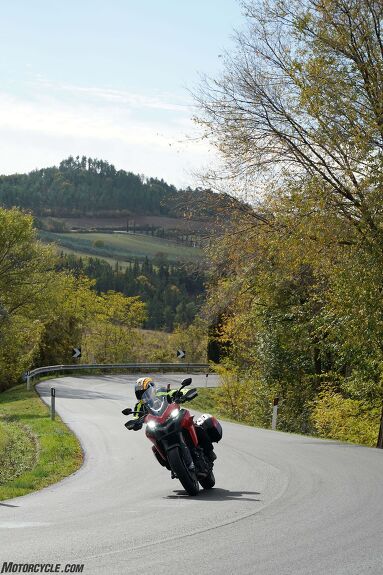
















































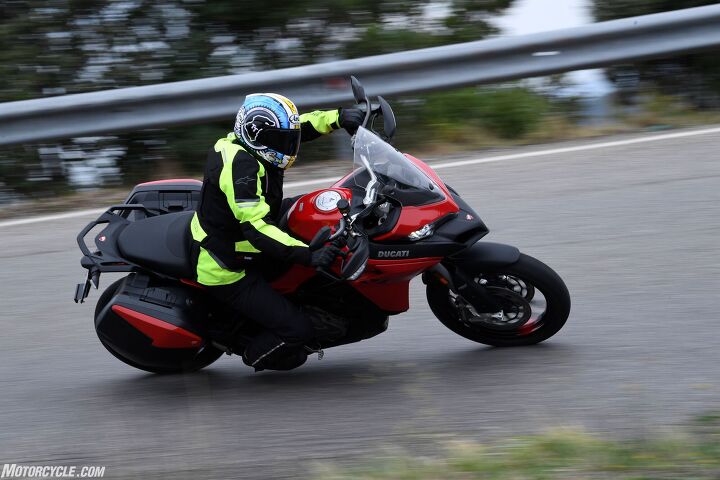













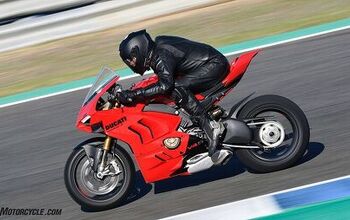


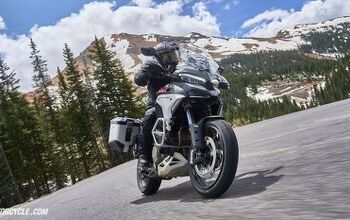








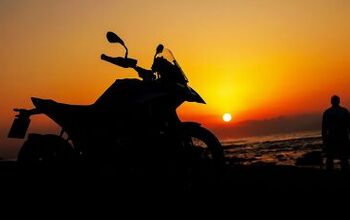


Comments
Join the conversation
Nice review Adam. And a great bike! It sounds like Ducati has fixed the few small issues (like weighing more than the 1200) that I had with the 950. The $15295 price is attractive for the base model as well. It's on my short list.
Enjoyed the review, I am eyeing the V2 as my next touring rig, also waiting to see what Guzzi is going to offer with the Mandello 100. decisions decisions!